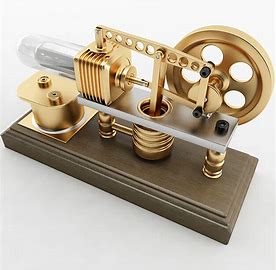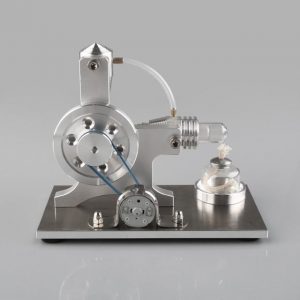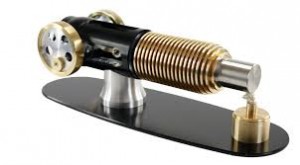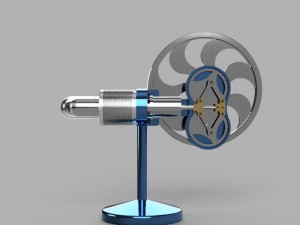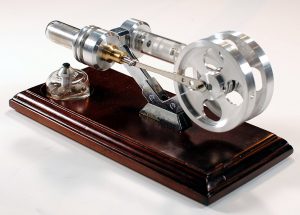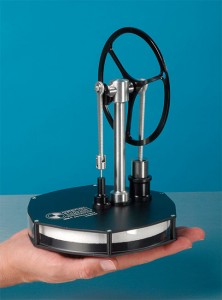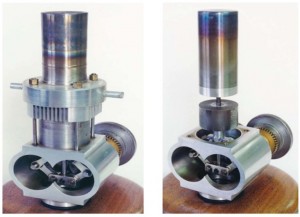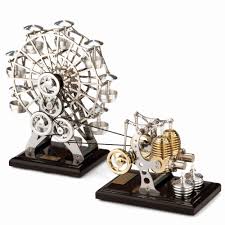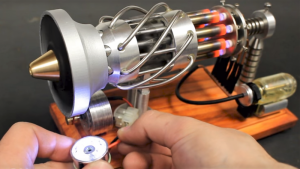Stirling Engine Models
Which One is Best for You?
Stirling engines have no valves and can run on any heat source, from sunshine to ice cubes.
Interesting, right?
So, you may have gotten the Stirling engine bug and now you want to know what’s available in the world of Stirling engine models.
Stirling engine models range from do-it-yourself projects that you build from junk in your kitchen to beautifully made commercial versions that will impress your friends.
Some engines are so beautiful they rightfully belong in art museums or in private art collections.
Summary of this Article
This article lists all the major types of Stirling engines and gives one or two model examples of each type.
You may want to read this page along with our Stirling engine animations page to get a better feel for how they work and which ones you are most interested in.
Some of the engines feature here are ready-to-run, others are kit engines and a one is a one of a kind work of art.
Click on any of the links to jump to that section:
- Alpha Stirling Engines
- Beta Stirling Engines
- Ringbom Stirling Engines
- Gamma Stirling Engines
- Low-temperature Difference Stirling Engines
- Rhombic Drive Stirling Engines
- Do-It-Yourself
- Works of Art
Alpha Stirling Engines
The first type I’m going to talk about is the Alpha Stirling engine.
This type has two separate cylinders, one that is heated and one that is cooled, attached together by a pipe behind the piston.
They each contain pistons that are attached to the same flywheel and compress alternately, causing the flywheel to turn.
Some features of the Alpha engine:
- Higher power-to-weight ratio
- Easier to separate the hot and cold parts
Beta Stirling Engines
A Beta Stirling Engine typically has only one cylinder, containing one piston and one displacer, which are often, but not always, connected by the flywheel.
The cylinder is heated at one end and cooled at the other.
There are many variations of the Beta Stirling Engine, including the Free piston Stirling engine and rhombic drive engines, which we’ll go over later.
Ringbom Stirling Engines
Ringbom engines are interesting because they don’t have any mechanical connection that moves the displacer.
The displacer moves because of the changing pressure inside the engine alone.
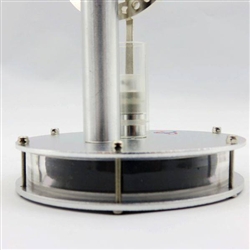
Here is an up-close look at the center of a Ringbom Stirling engine.
What Moves the Displacer?
Often, the displacer is either suspended above or supported from below partially by a spring.
The displacer is then attached to a large diameter rod.
Air pressure changes inside the engine push or pull on this rod and the displacer moves up and down, seemingly without anything moving it.
This makes it possible for the displacer to be at the top or bottom of the cylinder for roughly half of the cycle time.
This feature of some Ringbom Stirling engines is hard to understand.
Gamma Stirling Engines
A gamma Stirling engine has two cylinders, one containing the power piston and one containing the displacer.
The cylinders are located alongside each other and the air runs through a small port between the two.
The power piston and the displacer are often connected by the flywheel.
Low-temperature Difference Engines
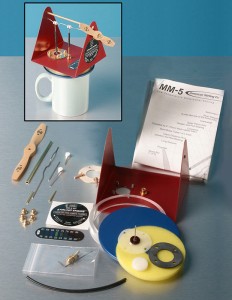
Our MM-5 Stirling Engine Kit. You can find instructions on assembly here.
A Low-temperature Difference (LTD) engine is sort of a variation of the Gamma Type Stirling engine with the power cylinder usually moved on top of the displacer cylinder.
But because they are designed to run on small temperature differences, they are shorter and a lot wider than flame heated engines.
Some low-temperature difference Stirling engines have run on temperature difference as small a difference as 1/2 of a degree Celsius.
Some Examples of a Heat of Your Hand Engine
Another version of this is the MM-7 Stirling Engine, which can run off the heat of just your hand! You can find it here.
This is very impressive to show to friends or set on your desk and have it run indefinitely with tiny (and often impossible to detect) temperature differences.
Rhombic Drive Stirling Engines
A rhombic drive Stirling engine has only one cylinder containing a piston and a displacer.
That means it’s a variation on the beta configuration.
The displacer and the piston work together to push down to one corner of a rhombus, which causes it to push down while simultaneously pushing out.
The corners that push out are connected to two flywheels which cause them to rotate in opposite directions.
As they rotate, they cause the rhombus to alternate between being flattened horizontally and flattened vertically while the piston moves up and down.
If you aren’t familiar with these, you might want to look at our animations page.
Rhombic Drives Aren’t on the Market
Entrepreneurs note: I wasn’t able to find any example of model Stirling engines with a Rhombic drive for sale, so there is an opportunity here for someone.
That is a shame because there are a lot of interesting things happening visually with these engines.
These engines can also be 100% mass balanced and very smooth running.
Do-It-Yourself
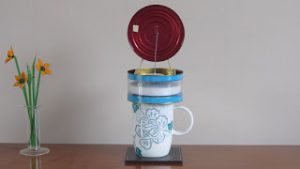
This Low-temperature difference engine was built by using junk from home and a few supermarket items¹.
If you are looking for an engine you can build yourself, a low-temperature difference Stirling engine might be the route to go.
We have a kit you can purchase here, but you can also read the Do-It-Yourself article here to find out how you can make one from junk that you can probably find in your kitchen.
Works of Art
Sometimes Stirling Engines are made strictly for their beauty.
Check out some gorgeous works of art below.
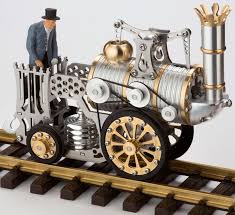
This Stirling Engine is modeled after a train and would serve as a beautiful addition to any collection.
This engine has two components and is modeled after a Ferris Wheel. There are a few models of Stirling engines that you can buy and I hope you now have a deeper understanding of each one.
Please Comment Below
Please tell us exactly what you were looking for when you came to this page. That will help us improve it and make it.
It also is a great place to leave your comments on (and a link to) any favorite models that you have.
Thanks.
¹Photo Credit: Myfordboy blog

